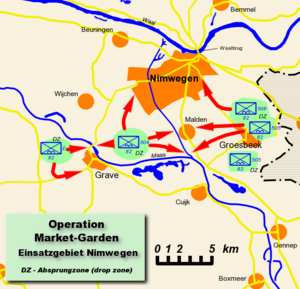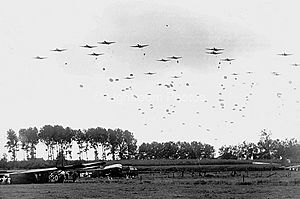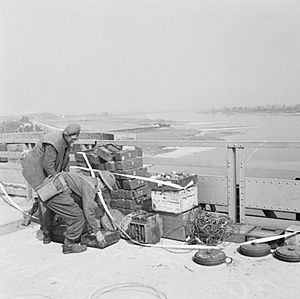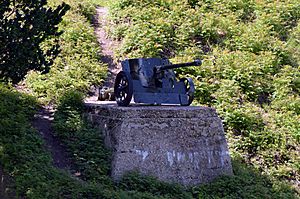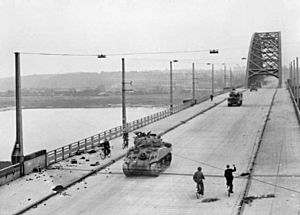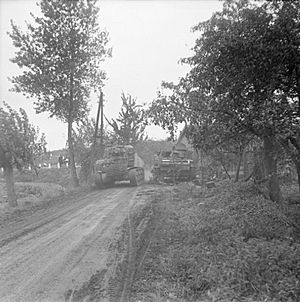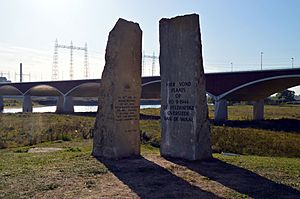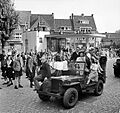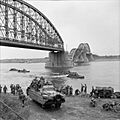Battle of Nijmegen facts for kids
Quick facts for kids Battle of Nijmegen |
|||||||
|---|---|---|---|---|---|---|---|
| Part of Operation Market Garden during World War II |
|||||||
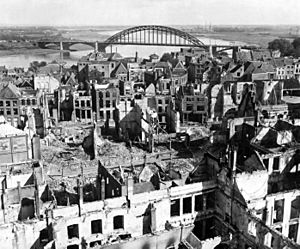 The Waal Bridge and north-east central Nijmegen, damaged during the battle. Photo taken on 28 September 1944 from the Dominican Church. |
|||||||
|
|||||||
| Belligerents | |||||||
| Commanders and leaders | |||||||
| Strength | |||||||
|
Elements of:
|
|||||||
| Casualties and losses | |||||||
|
479 wounded 178 missing( 508th at Wyler and Beek) 200 casualties(504th Waal River & Bridge) |
300+ (Waalbrug south) 267 (Railway bridge) 80 (Waalbrug north) |
||||||
The Battle of Nijmegen, also called the Liberation of Nijmegen, happened from September 17 to 20, 1944. It was a key part of Operation Market Garden during World War II.
The main goal for the Allied forces was to capture two important bridges. These bridges crossed the Waal River in Nijmegen, Netherlands. One was the road bridge, known as the Waalbrug, and the other was the Nijmegen railway bridge. Capturing these bridges was vital to help the British and Polish troops stuck in Arnhem. Arnhem was about 10 miles (16 km) north of Nijmegen. These Allied soldiers were surrounded by German forces. They were fighting hard to control bridges over the Rhine River.
However, German forces quickly gathered reinforcements in Nijmegen. This caused unexpected delays for the Allies. These delays eventually led to Operation Market Garden not fully succeeding. It took the Allies too long to open a clear path to Arnhem. Because of this, the British and Polish forces in Arnhem had to retreat. They suffered many losses. The fighting in Nijmegen also caused hundreds of civilian deaths. Many buildings in the city were badly damaged.
Contents
Why Nijmegen Was Important
The River Waal near Nijmegen was a big natural barrier. For a long time, there were no bridges over it. Then, in 1879, the Railway Bridge was built. In 1936, the Road Bridge, or Waal Bridge, was added. The Waal Bridge was an amazing piece of engineering for its time. It was the longest bridge of its kind in Europe.
When Germany invaded the Netherlands on May 10, 1940, Dutch engineers blew up the Waal Bridge. They did this to slow down the German army. But during the German occupation, the bridge was fixed. It reopened in 1943.
In February 1944, Allied planes bombed Nijmegen. They aimed for the railway station, which Germans used to move weapons. But the bombing was not accurate. Most bombs hit homes in the city center. About 800 civilians died. The Nazis used this event in their propaganda. They tried to turn people against the Allies. But their efforts failed. Most people in Nijmegen still wanted the Allies to free them.
By late August 1944, German forces in Normandy were retreating fast. The Allies quickly took over Northern France and Belgium. People in the Netherlands heard exciting news. They thought liberation was very close. This led to a day called Mad Tuesday, full of hopeful rumors. But the German army managed to regroup. They would not leave the Netherlands without a fight.
British General Bernard Montgomery then planned Operation Market Garden. It was a bold plan to surprise the Germans. Allied airborne troops would land by parachute. They would quickly capture key bridges over major rivers. Then, heavy tanks and vehicles could drive straight through the Netherlands. They would go past Eindhoven, Nijmegen, and Arnhem. The goal was to reach the Ruhr area in Germany. This area was vital for Germany's war factories. The airborne part was called "Market." The ground force part was called "Garden." The paratroopers would secure the bridges. This would protect the invasion route for the ground forces. The Allies hoped this operation could end the war before 1945.
Getting Ready for Battle
The success of Operation Market Garden depended on capturing many bridges quickly. American, British, Polish, and Canadian airborne forces had to take them intact. These bridges would clear the way for "Hell's Highway". This was the main road from Belgium to the north. The heavily armed British XXX Corps would advance along this road. They had many Sherman tanks and artillery. If they could cross all the major Dutch rivers in time, the war might end soon.
The 82nd Airborne Division was given the task of taking all bridges between Grave and Arnhem. This division included the 504th, 505th, and 508th Parachute Infantry Regiments (PIRs). Brigadier General James M. Gavin led them. The bridges included the Grave Bridge, four bridges over the Maas–Waal Canal, the Railway Bridge, and most importantly, the Waal Bridge near Nijmegen.
The main part of the 82nd Division and the 504th PIR would land near Grave. Their job was to capture the first five bridges. The 505th and 508th PIRs would jump at Groesbeek. They needed to secure the Groesbeek Heights. This would stop German counterattacks from the Klever Reichswald. Then, they would move towards Nijmegen and capture the Waal Bridge.
The Battle Begins
Capturing Bridges: Grave, Canal, and Waal
On September 17, at 12:30 PM, American paratroopers landed near the Grave Bridge. They quickly captured it. They successfully defended it against German attacks for a few hours. Another group of American soldiers, the 1st Battalion of the 504th, had to take four Canal bridges. Two of these bridges were destroyed by the Germans. But Bridge 7 near Heumen was captured by the Americans. By early morning on September 18, American companies occupied Grave without a fight. They waited for the British XXX Corps, who arrived at 8:30 AM.
Around 6:00 PM on September 17, the 1st Battalion, 508th PIR, moved towards Nijmegen. Their goal was to take the Road Bridge. But there was a misunderstanding. The American commander thought he should wait before advancing. This delay gave German troops enough time to get to the bridge first. The surprise attack was lost. German soldiers stopped the Americans from taking the bridge.
Marching on Nijmegen
September 17: Fighting at Keizer Karelplein
Around 10:00 PM, American soldiers advanced into Nijmegen. They were guided by a Dutch resistance member. He disappeared when they reached the city's southern end. Soon, they faced German machine gun fire. A big fight broke out at Keizer Karelplein, a large square. German soldiers shot from the center of the square and nearby houses.
Both sides received more troops. But on the morning of September 18, German forces attacked the American landing zones near Groesbeek. Most of the American troops in Nijmegen had to go back to defend Groesbeek. Only one company stayed in Nijmegen. They tried to capture the Road Bridge by taking a different route. They cleared out German guard posts and almost reached the bridge.
Waal Bridge: Not Destroyed
The Allies were very worried the Germans would blow up the Road Bridge. If that happened, Market Garden would fail. The Germans had already placed explosives on the bridge. But they never blew it up during the battle. German Generalfeldmarschall Walter Model believed the Allies would lose at Arnhem. He thought the bridge might be useful for a German counterattack. So, it was not destroyed on September 17.
On September 18, a Dutch resistance member named Jan van Hoof supposedly damaged the explosives. This is not fully certain. But he was arrested and executed the next day. He became known as the "Saviour of the Waal Bridge." After the war, an investigation found that Germans could have re-armed the bridge. But they still chose not to destroy it for strategic reasons. Another idea is that the German detonator simply failed on September 20.
September 18: German Troops Arrive
On September 18, General Model sent more German troops from Arnhem. He wanted to keep the Waal Bridge out of Allied hands. These German soldiers crossed the Rhine River and used the Waal Bridge. They then dug in at the Hunnerpark. These reinforcements helped the German SS troops regroup. They set up their headquarters on the north side of the Waal River. German paratroopers also prepared defenses for the Railway Bridge. The Americans had to wait for the British XXX Corps to help them take the bridges. This was a delay from the original plan.
September 19: Battle at Keizer Lodewijkplein
On the morning of September 19, Allied commanders met to plan their next move. They split their forces into two groups. One group would take the Railway Bridge. The other would take the Road Bridge. The arrival of British troops made the American commander feel more secure. He sent some of his soldiers from Groesbeek to help with the attack.
At 4:00 PM, the Anglo-American forces moved into the city. A fierce battle started at Keizer Lodewijkplein. British tanks and armored vehicles exchanged fire with German anti-tank guns. German infantry were dug in at the Valkhof fortress. American paratroopers took cover in nearby buildings. Heavy German artillery also shelled the attackers from across the Waal River.
It became clear that a direct attack on the German positions would take too long. The Allies needed to help the British troops in Arnhem quickly. To do this, they had to capture the northern ends of both bridges. This would cut off the German forces on the south bank. To achieve this, infantry would have to cross the river while under fire.
American soldiers crossed the Heumen bridge on the evening of September 19. They set up camp. Brigadier General Gavin ordered Captain Julian Cook to find boats to cross the Waal. It took time to get canvas boats transported from Belgium. This delayed the river crossing by a day. Only 26 boats arrived.
September 20: Fighting in Nijmegen City Center
To make the river crossing work, the Allies needed to attack the south sides of the bridges again. This would distract the Germans. Nijmegen's city center had to be cleared block by block. This operation began on the morning of September 20 at 8:30 AM. It went surprisingly fast. The German defenders were pushed back easily. Much of the fighting happened on rooftops. Paratroopers moved quickly from one roof to the next. Only in the Kronenburgerpark did the advance slow down. Here, elite German SS troops had a clear view and strong positions. Meanwhile, German paratroopers attacked American forces at Groesbeek and Mook, but they failed to break through.
September 20, 3:00 PM: The Waal Crossing
The planned river crossing was delayed many times. Getting the canvas boats from Belgium was hard. "Hell's Highway" was narrow and often blocked by burnt-out vehicles.
The crossing finally happened at 3:00 PM. It was about two kilometers downstream from the Waal Bridge. Two British Spitfires were supposed to provide air support. But German anti-aircraft guns shot one down. The other Spitfire returned to England. The American soldiers crossing the river faced heavy fire. German tanks, artillery, and small arms attacked them. They suffered many losses. Some boats sank or flipped over.
Despite the losses, at least 16 boats made it across. A telephone line was laid on the riverbed for communication. In several waves, most of the American assault force successfully crossed the river.
By late afternoon, the Americans had taken the northern end of the railway bridge. They prepared for a German counterattack. But instead, about 200 to 300 German soldiers surrendered. Around the same time, another American group captured the northern end of the Waal Bridge after tough fighting.
Time was running out for the British tanks and artillery on the south bank. They were low on ammunition. This, along with supply problems, was a big issue. The XXX Corps needed a lot of ammunition to continue their advance to the Rhine.
In the battle for the Waal Bridge, over 300 German soldiers died. 60 were captured. The rest managed to escape.
What Happened Next
The March Stops
Around the same time the Nijmegen bridges were captured, British paratroopers in Arnhem had to surrender their part of the Arnhem Bridge to the Germans. A quick advance from Nijmegen to Arnhem was blocked. Many things caused this delay. It was getting dark. The Allies didn't know the land ahead. German reinforcements arrived from Arnhem. There was ongoing fighting and confusion in Nijmegen. And there were constant supply problems on "Hell's Highway."
The XXX Corps' advance was delayed for another 18 hours after taking the Waal Bridge. After five days of fighting, they were too tired to continue their attack. On September 21, a battle near Elst stopped the XXX Corps from moving further towards Arnhem. On September 22, the 43rd (Wessex) Infantry Division helped by creating a path to Oosterbeek. This is where British paratroopers were holding out against many more German soldiers. They linked up with Polish paratroopers near Driel.
Attempts were made to still make the Battle of Arnhem a success. But these failed on September 23. On September 24, the Allied generals decided to give up on Market Garden. They pulled their troops out of Arnhem. The front line moved back to Nijmegen. Remaining British troops tried to escape south or hide in German-occupied areas. During Operation Berlin (September 25–26), over 2,400 British soldiers were rescued with Canadian help. Operation Pegasus (October 22–23) saved another 100.
Nijmegen: A Frontline City
After the Allies left Arnhem, Nijmegen became a frontline city again. It was bombed regularly for the next five months. Historians wonder why Nijmegen wasn't evacuated right after its liberation. This could have saved hundreds of civilian lives. German forces tried many times to destroy the Waal Bridge, but they always failed. Their best attempt was on September 29. German Kampfschwimmer (combat swimmers) placed floating mines on both bridges. They managed to destroy the middle part of the Railway Bridge. They also blew a hole in the Road Bridge. But the Road Bridge was saved with a British bailey bridge. The Germans counterattacked Nijmegen from September 30 to October 8. But they were pushed back with heavy losses.
Changes in Leadership
On September 17, the mayor of Nijmegen, Marius van Lokhorst, was removed from office by the Allies. A new mayor, Petrus van der Velden, was put in place on September 19. Many people in Nijmegen criticized this choice. They felt he had cooperated too much with the German occupiers before. On October 16, 1944, Charles Hustinx became the new mayor. He stayed in this role until 1968.
Remembering the Battle
During the Battle of Nijmegen, there were only two reporters with the American 82nd Airborne Division. They were busy covering other events. So, the news at the time didn't focus much on Nijmegen. Later, historians had to piece together what happened from other sources.
Historian Joost Rosendaal found that people remember the bombing of Nijmegen in February 1944 more clearly. But the liberation and the five months as a frontline city caused similar numbers of deaths. Nijmegen suffered about 7% of all war deaths in the Netherlands. This was a very high number for one city. Many of those who died were civilians. For many years, they were not officially honored. Nationalistic memorials often focused on soldiers and resistance members who "died for the fatherland."
During the war, 10,000 people in Nijmegen were wounded. 5,500 of them were permanently disabled. 5,000 houses (nearly a quarter of all homes) were destroyed. Another 13,000 homes were damaged. With 12,000 people left homeless and 3,000 evacuees, there was a huge housing crisis after the war.
Images for kids



